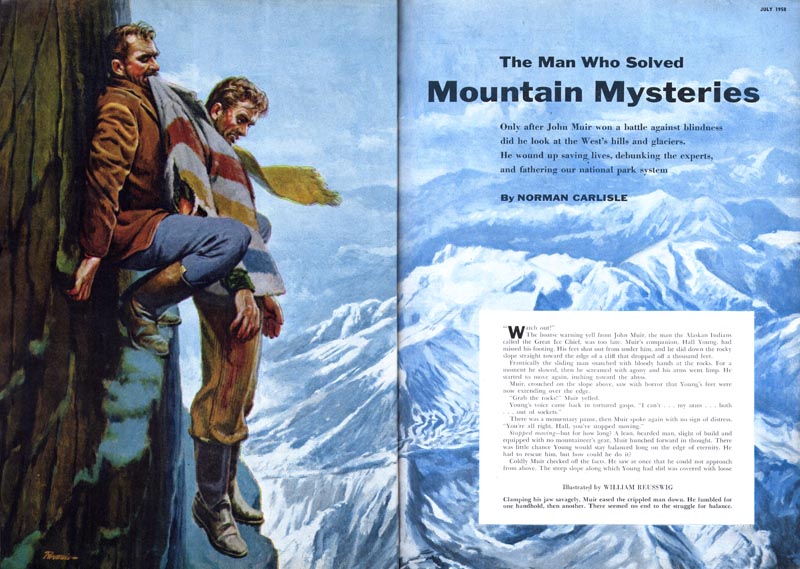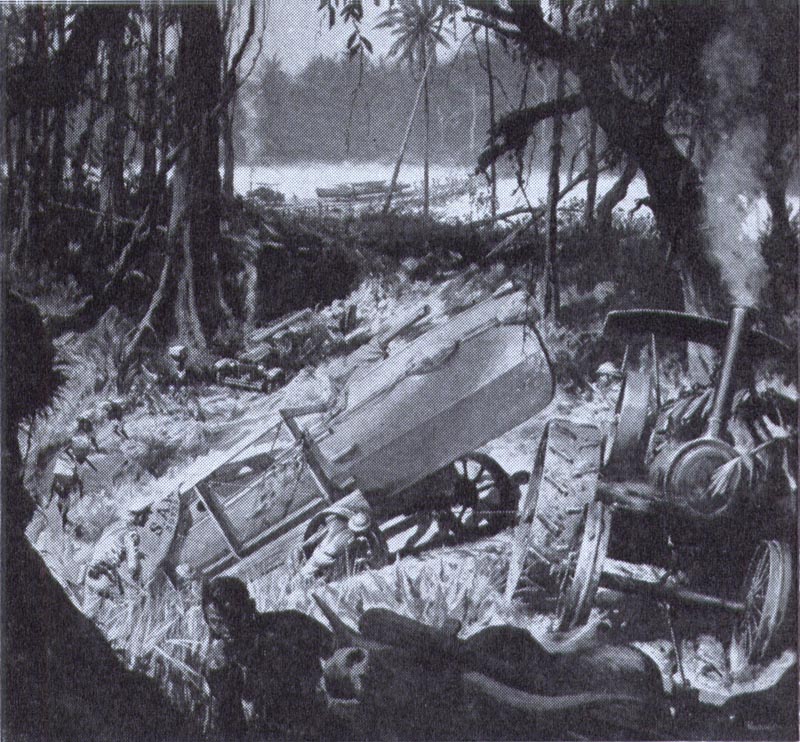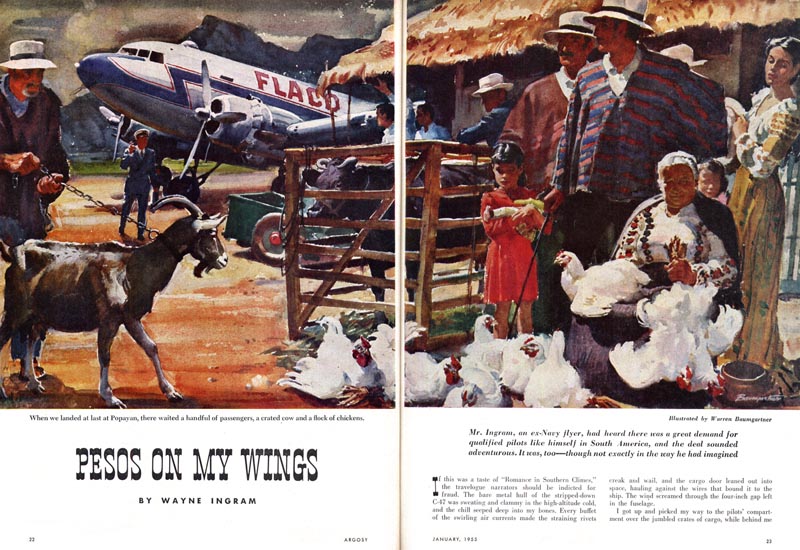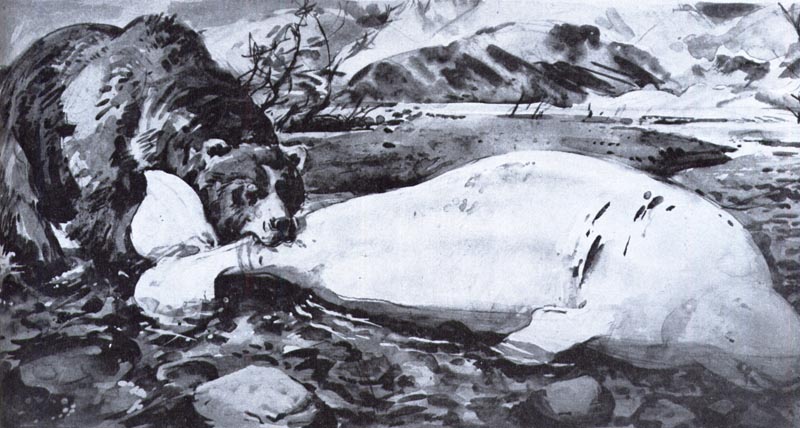
"One of the most amazing facts of human endurance in the first World War was the engineering task of transporting a makeshift gunboat over pontoon bridges and through the trackless African jungle. The commission to illustrate this story was given to William Reusswig."

"Apart from the design of scale and deep space which contributed so much to the reader's understanding of the difficulties involved, there remained the problem of models, both human and mechanical. These were composed from separate pencil studies and fitted into the large, almost abstract design of dark and light."

"Good illustrators are painstaking craftsmen and indefatiguable researchers. We are sometimes asked if they actually read the manuscripts. This, of course, is a ridiculous question. Not only do they study the script thoroughly; it is not unusual for them to do considerable supplementary reading related to the story for background information."
"Characteristic of the insistence upon convincing reporting that I have already mentioned was the procedure of Warren Baumgartner..."

"... who was given the commission to illustrate the bear and whale story. After making a series of rough sketches for arrangement and composition only, he began his research on the script calling for a Kodiak bear dragging the tethered body of a white whale upstream. A visit to the Museum of Natural History provided him with photographs of the white whale - it was the smallest known variety - with details of length, head construction, fins and other characteristics. Sketches of the gigantic stuffed kodiak bears at the Museum recorded proportions and color. Although armed with this research material, Baumgartner was still faced with the problem of visualizing the action in a landscape setting. He modeled the animals in plasticine, coated the bear and whale models with general coloration, then set them on a table under artificial light."

"His comprehensive sketch in watercolor (made final reproduction size of 8 x 16 inches ) was submitted to the editors and was okayed with several minor changes."

"The final painting in watercolor was made out-of-doors by placing the scale model in shallow water so that the reflection of the 'dead' white whale could be studied in natural illumination. Even pebbles were collected and placed as they appear in the sketch to simulate rocks in the stream. Other researches of Alaskan landscape and vegetation were taken into account for background vista."

"Even in the black and white reproduction of the final painting shown here I think one can see that solid reality I mentioned earlier - a picture illustration of an unusual incident so convincing that readers will have no doubt of its reality."
* my William Reusswig Flickr set.
* my Warren Baumgartner Flickr set
Based on that first cliff-hanger scene, it looks like ol' William Reusswig needs to go back and do a little more research into the laws of physics and the laws of dentistry.
ReplyDeleteBoy, it would be nice to have the time to sculpt your own reference! Everyone expects things to be done yesterday, now. Great series, as usual, Leif!
ReplyDeleteIn reference to all the the detailed research described in today's blog, I suspect much of that changed in the 60's.
ReplyDeleteMy illustration teacher, Bob Foster moved to N.Y. and did a lot of pocket book covers through the 60's and 70's. He told me he didn't have time to read the manuscripts due to his heavy schedule, so he would hire prostitutes to read them during the day, which was their "off" the job hours. ;-) They would glean out the important information that he needed, which saved him much needed time to work on other assignments.
I've been noticing that many dust cover illustrations for novels today, are generic to the story. Perhaps, a story taking place in Ireland, might have a reproduction of a fine art painting of rolling green hills and grazing sheep. I guess that is cheaper than commissioning an illustrator to read the manuscript, research the story, develop layouts and color roughs and then do the final illustration. But, it was also a different reading audience in the 50's, and I believe the story illustrations were not only more important to the reader, but was a prime motivating factor to read the stories.
During the 20's and 30's, the top magazines would team a popular writer with a popular illustrator, and the public associated the two with equal admiration. It also gave the illustrator a near guarantee of a certain number of annual illustration assignments from that magazine.
Norman Rockwell's research for illustrating the 1936 Tom Sawyer and 1940 Huckleberry Finn novels, was unsurpassed for authenticity and accuracy... even though the stories were fiction. Rockwell never cut corners when it came to research and believability, and that is probably a big part of why he was so popular.
Another thoughtful and enlightening week, Leif.
Thanks,
Tom Watson
Thanks so much for the informative blog. It's invaluable to learn so much about illustrators' processes. It has all seemed like a mystery in the past. But to have a resource like this on the 'net is better than a library of how-to books!
ReplyDeleteThat's a beautiful watercolor by Baumgartner.
ReplyDeleteLate, but will add a note to a fine 'adventure' week on TI. Thanks, also, Leif, for posting Ludekins, Galli, and Bomburger's, that I have never seen...thought I'd seen all their work. Thanks to Tom for his always well written additions. Toward the 'end of things' here....about the 80's....an illustrator friend built a separate studio where he worked nights and could sleep. A few art directors would commission a job on Friday, for a Monday delivery. He ended up with a divorce. Agree with Meredith....a great source, and better than a library. Chas. A.
ReplyDelete